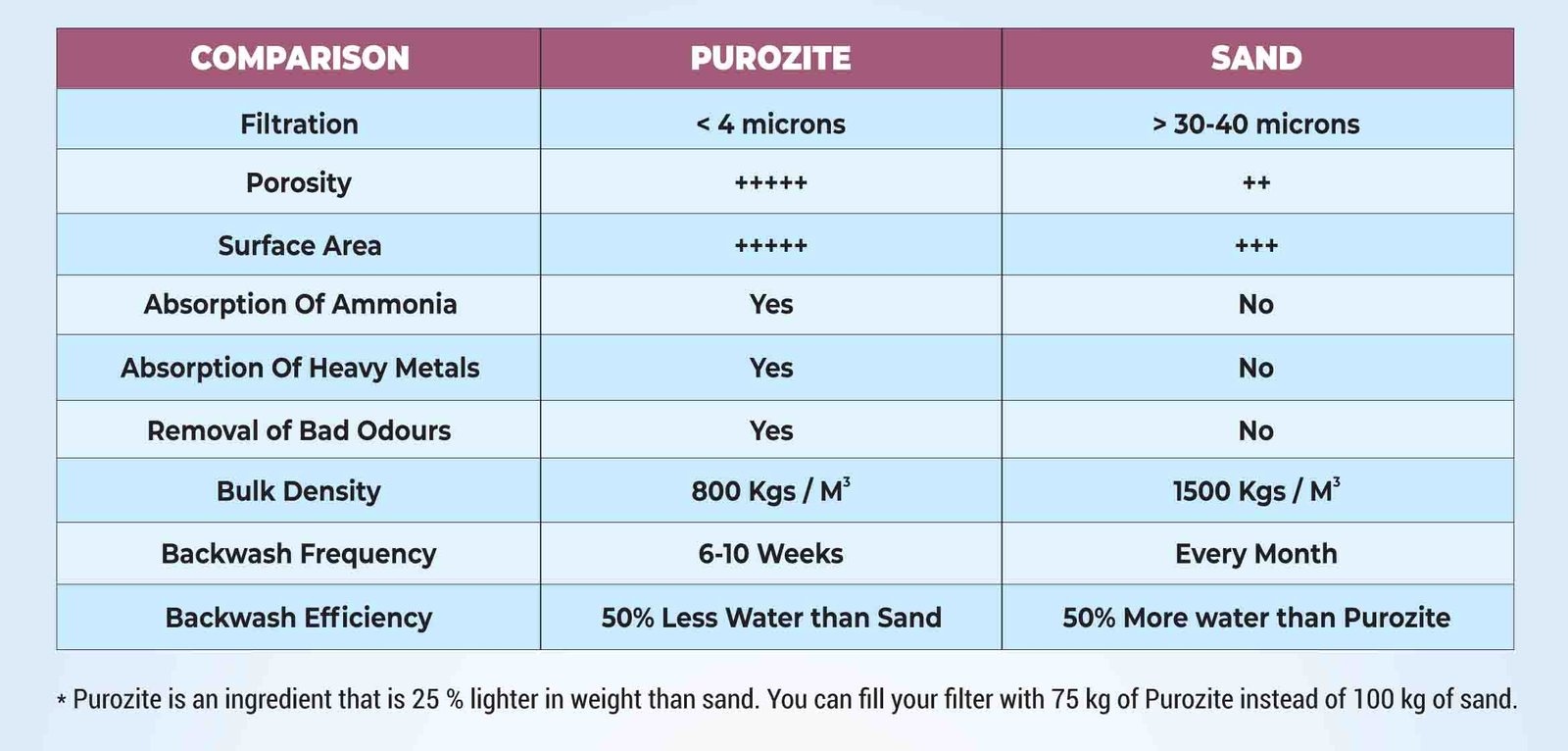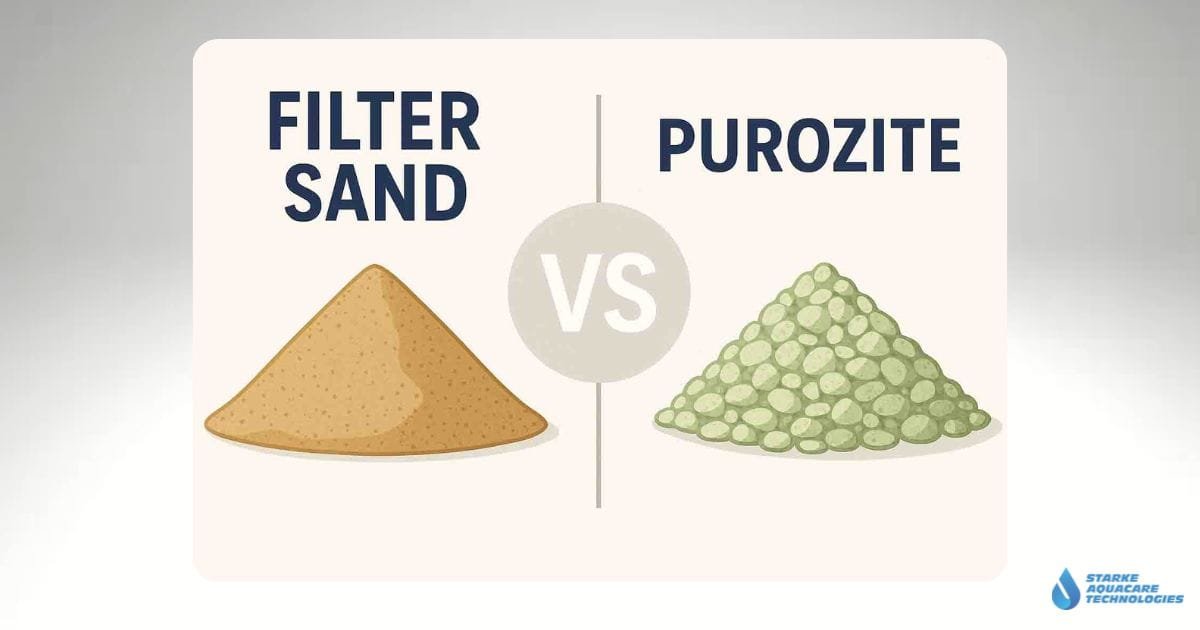Water filtration requires the right media to ensure clean, safe, and efficient treatment. Two popular options for various applications are filter sand and Purozite. While both serve the same purpose, their properties and performance differ significantly. This blog provides a detailed comparison to help you make an informed decision.
What Is Filter Sand, and How Does It Work?
Filter sand, commonly used in water treatment, consists of fine silica grains that trap contaminants as water flows through. It operates through mechanical filtration, where suspended particles adhere to the sand’s surface and settle between its grains.
Filter sand has been the industry standard for decades due to its availability, affordability, and consistent performance. However, it requires regular backwashing to maintain efficiency, as clogging can occur over time.
How Does Purozite Differ from Filter Sand?
Purozite, a high-performance filtration media, offers superior filtration due to its high porosity and adsorption capabilities. Unlike filter sand, Purozite has a microporous structure that allows it to trap finer particles and remove ammonia through ion exchange.
Additionally, Purozite has a higher dirt-holding capacity, meaning it requires less frequent backwashing than traditional filter sand. This property makes it an attractive choice for industries seeking cost-effective and high-efficiency filtration solutions.
Which One Provides Better Filtration Efficiency?
Filtration efficiency depends on particle retention and contaminant removal. While filter sand effectively removes suspended solids down to 20 microns, Purozite can trap particles as small as 5 microns. The smaller pore size of Purozite enhances its ability to capture fine debris, leading to improved water clarity.
Moreover, Purozite’s ion-exchange properties enable it to remove ammonia and other dissolved impurities, making it superior for applications where water quality is a priority.
How Do Their Maintenance Requirements Compare?
Regular maintenance ensures optimal performance for any filtration media. Filter sand requires frequent backwashing to prevent clogging and maintain flow rates. Over time, sand compacts and forms channels, reducing its effectiveness and necessitating replacement every 3–5 years.
Purozite, in contrast, needs less frequent backwashing due to its higher dirt-holding capacity. It also retains its structure longer, extending its lifespan to 5–7 years. Additionally, its ability to remove ammonia reduces the biological load in filtration systems, minimizing maintenance efforts.
Which One Is More Cost-Effective?
Initial costs and long-term expenses determine cost-effectiveness. Filter sand is more affordable upfront, making it a budget-friendly choice for large-scale applications. However, due to its shorter lifespan and frequent backwashing needs, operational costs can increase over time.
Purozite has a higher initial investment but offers long-term savings by reducing water consumption, energy use, and replacement frequency. Industries aiming for sustainable and cost-efficient operations may find Purozite to be the better investment.

What Are the Ideal Applications for Each Media?
Filter Sand Applications:
- Municipal water treatment plants
- Swimming pools
- Industrial wastewater treatment
- Irrigation systems
Purozite Applications:
- Drinking water filtration
- Aquariums and aquaculture systems
- Cooling towers
- Food and beverage processing
How Do They Impact Environmental Sustainability?
Sustainability plays a crucial role in choosing filtration media. Filter sand is a naturally occurring material but requires extensive mining, which affects the environment. Its frequent backwashing also increases water wastage.
Purozite, due to its longevity and reduced water consumption, provides a more eco-friendly alternative. Its ability to remove ammonia also improves water quality, making it a preferred choice for environmentally conscious industries.
Frequently Asked Questions
- Can I Replace Filter Sand with Purozite in an Existing System?
Yes, most filtration systems allow a direct swap, but adjustments in backwashing pressure may be necessary to optimize performance.
- How Often Should Purozite Be Replaced?
Purozite lasts between 5–7 years, depending on usage and maintenance. Proper backwashing extends its lifespan.
- Does Purozite Require Special Handling?
No, it can be installed and maintained like regular filter sand, though its ion-exchange capability provides additional benefits.
- Which Media Is Better for Residential Pools?
Purozite provides superior water clarity and requires less maintenance, making it a better choice for residential pools.
- How Does Purozite Improve Water Quality?
Its microporous structure removes finer particles and ammonia, leading to cleaner, healthier water.
Conclusion: Which One Should You Choose?
Both filter sand and Purozite offer advantages depending on application needs, budget, and maintenance preferences. Filter sand remains a reliable choice for general filtration, while Purozite provides enhanced efficiency, longevity, and sustainability. By evaluating your specific requirements, you can select the media that best aligns with your operational goals.

